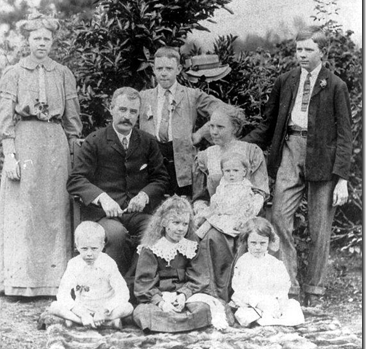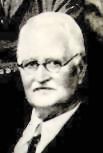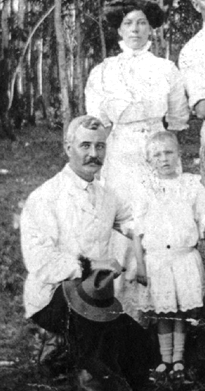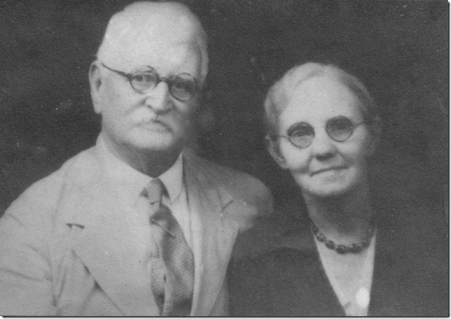Back to search results
Name: GARVIE, John Sutherland




Nee: son of Lawrence (1845-1918) and Johanna Garvie, bro of Donald Sutherland Garvie and Ebenezer George Garvie
Birth Date: 21 May 1870 Edinburgh
Death Date: 22 Oct 1952 Durban, South Africa
First Date: 1904
Last Date: c. 1912
Profession: Drumkey 1909 - Railway Dept. Traffic Dept., Guard, 1st Class
Area: 2nd Railway Ave., Nairobi. HBEA 1912 - Kibigori, Nandi, Nakuru
Married: In Bloemfontein 3 June 1891 Sarah Bethia Elizabeth 'Lily' Skea b. 7 Dec 1873 Orange Free State, d. 22 May 1952 Durban
Children: Frances May (Parker) (30 May 1892 Bloemfontein-1961); Lawrence (14 Sep 1894 Johannesburg-1935); John James Sutherland (28 Dec 1896 Kimberley-1965); Johanna Alice (Cole-Edwardes) (1900-1993); Charles William (1904 Nairobi); Margaret Constance (Viljoen) (1906-1988), Donald Stuart (1908 Nairobi- 1916)
Book Reference: SE, HBEA, Hut, Drumkey, Web, Land, Advertiser, Colin Garvie, North, Red Book 1912
War Service: WW1 with EASC - Sgt. In charge of the field force canteen at Nizina
General Information:
SE - J. Garvie - 2nd Railway Ave. - Sept 1907
Garvie Family Album - John Garvie was born in Edinburgh 1870. He was a well known businessman in Kenya and S. Africa, died in Durban 1952. Son of Laurance Garvie of Scotland
Land - 1911 - John Garvie - Grazing and agricultural, 3100 acres - Nandi District - 2/3/04 - Leasehold for 99 years from 1/10/10 - Registered 7/4/11
Advertiser - 16/4/1909 - J. Garvie, Station Master, Nakuru - birth of a son.
Colin Garvie - Farmer in Nandi. Also said to have been Station Master at Nakuru. During the Great War .. Near Nizina, with a small escort of Natives, he was ambushed by the Germans. His horse was shot from under him. He managed to slip off and made his escape.
"Garvie got wagon up escarpment on new road Uasin Gishu Nandi District" - Reference in the National Archives, Kenya c. 1912
John Garvie was born to Laurence and Johanna Garvie at 1.30 pm on the 21st May, 1870 at 12 Union Street, Edinburgh. John probably spent his early schooling in Scotland. At about the age of ten John arrived in Knysna, Cape Colony with his parents. By 18 John had moved with the family up to Kimberley where he then launched out on his own enterprising way. Here he came into contact with John Orr.
John Garvie, John Orr, McCullach and Bothwell opened the first John Orr Store in Kimberley. John was a draper. His experience in this field probably helped his father start up as a draper in Johannesburg some years later. McCullach and Bothwell left and opened a men's store in Johannesburg. John Orr then opened a branch in Bloemfontein under John Garvie's management. Lily Skea frequently passed the shop on her way to piano lessons. John watched her go by. He admired her and her long golden hair. He was a fine violinist and also had a lovely voice. John was soon into the concert world of Bloemfontein. Lily qualified and became a concert pianist. That was how they met and fell in love. 21 year old John took the hand of Lily who was then 18 and were married in the St. Andrew and Michael Cathedral of Bloemfontein on 3rd June 1891. Undoubtedly the family came across from Kimberley. ……..
John had the typical wanderlust of a Scot, and took his young bride from one horizon to another. In the Knysna district he dug for gold in the alluvial Millwood Goldfields. He later became a transport rider between Mossel Bay and Millwood. For a couple of years he was an officer of the Salvation Army and served in Port Elizabeth and East London. During the Boer War John served with the Newcastle Town Guard. May, Trixie, Lawrance and James were born during this time of wandering. ……….
John Garvie recorded the circumstances of their move to Kenya. "They were," he wrote, "a family of seven sons, John, Donald, Lawrence, James, William, Charles and George who with their father decided to emigrate to British East Africa and take up farming if land was available at a reasonable price. It was in January 1904 that John and his father met Mr Russell Bowker from BEA then paying a visit to Johannesburg who informed them that the Government had decided to open up certain districts for settlement and was calling for settlers." ……..
Bowker advised, says John Garvie, "that one or two members of the family should proceed to Nairobi and get in touch with the Land Officer there ….. So acting on Mr Bowker's advice the family delegated John and Lawrence to proceed to Nairobi and do their best each member agreeing to contributing a share towards expenses." John and his brothers Donald, James (Jim) and George, each bought 3,000 acres in Kenya in 1902. Land was cheap at a halfpenny an acre plus survey fees. In the years that followed hundreds of settlers, many of them Boers from South Africa, took up their options mainly in the fertile plantation belt east of the Aberdare Mountains, in the Great Rift Valley between Naivasha and Nakuru, and further west on the Uasin Gishu plateau.
The Garvies arrived at Kilindini on the central African coast and spent a while in quaint Mombasa. John and Lilly with their family found the coast too hot and moved to Nairobi by rail. The trip was always unforgettable with staggering sights of wild herds and the glistening dome of Kilimanjaro in the distance. Soon after arriving in Nairobi John, Donald and James went to investigate the situation regarding their land in Nandi, a region where the natives were savage and very hostile. Britain's intention to settle this region resulted in large scale native antagonism and bitter clashes, "the vested rights of pristine inhabitants on the one hand, and the impatient demands of intolerant immigrants on the other fomenting endless trouble." A punitive expedition against the Nandi had to be mounted in 1905 before farmers could be peacefully settled.
The brothers, recognizing the danger, returned to their families in Nairobi. Nairobi was a rough place to be in. Nearly everyone was a railway official. Donald decided to settle in Nairobi while James returned to South Africa. John and George retained their property. It was some years before Britain gave the "all clear" for the farmers to settle on their lands. John did get work as a guard on the railway and became Station Master at Nakuru.
Errol Trzebinski quoting from the unpublished memoirs of Alfred Johansen, 'The Kenya I Knew, 1904-1963', says that a certain J.Garvie introduced bioscope to Kenya. This was not the case but rather his brother Donald. The homes in Kenya were like those in any other town only that in Nakuru they were built on pillars and trellised all around because of the wild animals. In 1902 Nakuru consisted only of a bungalow and the little station. Nakuru was a lovely little town with a beautiful lake. At dusk the sky was pink with flamingos going to roost. The lake fringe hosted flocks of guinea-fowl, geese, duck and waders. Hippo inhabit the brackish waters. After dusk mosquitoes made life unbearable. Often at night the zebra would stampede past their home, fleeing from marauding lions.
Joan, their daughter recalls, "Mom always used to say how miraculous it was that we were cared for by our Heavenly Father. Every night, before going to bed, we sat at Mom and Dad's knees. Dad read from "Pilgrim's Progress". We would chat and then say prayers. "What wonderful Christians they were! Mom was really a missionary. I remember her traveling through lion country, no gun (I don't think she knew how to use one), an African guide with a lantern, to deliver the magistrate's baby three miles outside the town of Nakuru."
In 1905 the brothers moved to their Nandi farms on the Uasin Gishu plateau. The family lived in large tents until more suitable homes were built. The centre tent was the living room and bedrooms were pitched on either side. A small room served as a kitchen with a coal stove. Outside was a "Dutch oven"in which Lilly baked bread. The family farmed with cattle, pigs and poultry trading with the African people. John acquired one third of an acre freehold at 1s 4d from the Government and two-thirds on a 99 years' lease at a halfpenny an acre. They were the only Europeans living on the plateau then. Lilly described it as "the loveliest country she had ever seen, green and fertile, well stocked with game. The streams that flowed there were crystal clear. Leopards would often rub themselves against the tents of their home at night." While on such a trip down into the Kibogori John was bitten by a mosquito. He contracted malaria. There were no medical services in Nandi. There was a doctor in Nakuru and others in Nairobi but they were all far. Soon after little Joan also got malaria and she needed to be sent back to South Africa. John continued for another 18 months. He sold his farm and returned to South Africa.
When Donald, who had remained in Nairobi died, John returned to Kenya for about six weeks to fetch May who had remained behind in Kenya and to help finalize Donald's estate. During the Great War, John served with the East African Service Corps and was sergeant-in-charge of the field force canteen at Nizina. Near Nizina, with a small escort of Africans, he was ambushed by the Germans. His horse was shot from under him. He managed to slip off and made his escape.
After the War John and Lily returned to Bloemfontein. John passed away on the 22nd October,1952 aged 82 years.
North - arr. Mombasa from Lourenco Marques with 5 children 13-12-1904; Appt. Guard 1st Class 13-5-1905
Red Book 1912 - J. Garvie - Nandi
Back to search results




